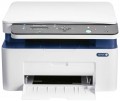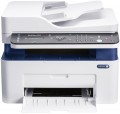Autofeed
The maximum amount of sheets that can be loaded into the MFP's document autofeed at one time.
The autofeed makes it easy to scan and copy a large amount of documents - just load a stack of sheets and turn on the programme, after which each document will be automatically fed for scanning. An auto-feed MFP is worth considering if you frequently scan or copy a large amount of documents.
Data transfer
—
Connection to PC (USB). USB is a universal interface used to connect various devices in computer technology, and it is the most popular among these standards nowadays. In this case, it is used to connect the MFP to a computer.
— Network connection (
LAN). Port for wired connection to LAN and/or the Internet. This feature allows you to use the MFP in the format of a network device — getting access to printing, scanning, etc. from any computer of the network, or even use cloud printing (see below). At the same time, some models may require a print server for operating via LAN — a separate PC, router or NAS server responsible for managing the MFP and acting like an intermediary device between the MFP and the rest of the network. However, most modern MFPs can also work in peer-to-peer networks — without a print server, with a direct connection through a simple router.
An alternative to LAN is wireless Wi-Fi (see below); a wired connection is less convenient due to the need to put cables, but it is more reliable and cheaper.
—
Wi-Fi. A technology used to make wireless connection to LAN and/or the Internet, and to connect devices directly to each other. For the last option, see
Wi-Fi Direct below; and a network connection allows the MFP to operate as a network device — similar to the LAN described above. At the same time,
...a wireless connection is somewhat more expensive than a wired one, but it is more convenient because of cable absence.
Modern MFPs may use different Wi-Fi standards — most often it is Wi-Fi 4 (802.11n) and Wi-Fi 5 (802.11ac). In most cases, you should not pay special attention to this nuance: the standards differ primarily in speed, however, these differences are not significant regarding the tasks MFP are operating with; and there are usually no problems with the compatibility of different standards with each other.
— Card Reader. Slot for reading memory cards, usually, with the feature of direct printing (see above). In this case, this function is convenient primarily because memory cards are widely used in modern photo and video cameras; thus, the card reader allows you to quickly and conveniently print the footage — just remove the card from the camera and install it in the MFP. However, this function can be also useful for exchanging data with other devices — for example, laptops; and in some models of the MFP, it is even possible to work in the mode of an external card reader for a PC.
— USB. A classic USB connector for connecting various external media — flash drives, digital cameras, external hard drives, etc. The presence of such a connector usually means at least the possibility of direct printing the content from the connected device, without the need to use a PC. However, there may be other purposes of use, such as copying scanned materials to external media.
— Bluetooth. The technology of wireless communication between various devices is convenient primarily due to the absence of wires. The specific use of Bluetooth in multifunction devices may vary. Some models use such a connection to connect to a PC; this is especially convenient for laptops — almost all modern laptops have built-in Bluetooth modules. Other MFPs allow you to send files from smartphones, tablets and other mobile devices for printing via Bluetooth, or copy scanned materials to external devices. There are models that combine these functions in one way or another. Such details should be clarified separately.
— NFC. Short-range wireless standard with a range limit about 10 cm. Most often used to simplify connection via Wi-Fi or Bluetooth (see above): no need to fiddle with the settings, just bring an NFC-compatible device to the NFC of the MFP and confirm the connection. The other way to use NFC is to automatically send materials for printing when you bring your smartphone or tablet to the device; such feature is usually carried out through a special application released by the MFP's manufacturer.
— Wi-Fi Direct. A feature found on models with built-in Wi-Fi modules (see above). Direct support allows you to connect other Wi-Fi devices (laptops, smartphones, cameras, etc.) to such an MFP directly, without using a router and a local network. This can be especially convenient if there is no network equipment, or if it needs to be additionally configured. The functionality of the Wi-Fi Direct connection is generally similar to Bluetooth (see above); the main difference is that Wi-Fi provides a faster and more reliable connection with a greater range. This is especially useful for transferring large volume of data — for example, sending large documents for printing or copying high-resolution scanned materials. In addition, such a connection is better suited for direct printing from cameras — Wi-Fi is the most common type of wireless connection in that devices.
— AirPrint. Same function as above (Wi-Fi Direct). Allows you to connect to a device without using a router or installing specialized drivers. However, in this case, we are talking about connecting Apple equipment — iPhones, iPad, Mac laptops. AirPrint-enabled printers are natively compatible with devices running iOS or Mac OS software. Printing can be done via a wireless Wi-Fi connection, an Ethernet cable or via a regular USB connection.More Features
Amazon Alexa, Google Assistant, Cortana. The presence of one or more of these names in the specs of the MFP means that the device is compatible with the corresponding
voice assistant — a system that allows you to give commands to various devices using your voice and receive voice notifications. Note that this is usually not about the presence of an assistant in the MFP itself, but about the ability to connect the device to a gadget equipped with a voice assistant — for example, a smartphone or laptop. However, this feature provides additional convenience — it allows you to control the MFP with just your voice, without using the control panel or touch screen, in particular, to send various files to print. At the same time, you should note that the functionality of the voice assistant and the possibilities for connecting it may be limited. For example, Amazon Alexa is able to print only content directly associated with the assistant (shopping lists, calendar templates, coloring books, and some other types of materials) and does not allow you to randomly select a file for printing from a third-party source, and you need to connect a device with such a voice assistant via a local network — this cannot be done directly via USB.
— Keyboard. In this case, we are talking about a full-fledged QWERTY keyboard, like those used in computers and laptops. For basic tasks, such equipment is not required, so the keyboard is a sign of a fairly adv
...anced device. Models with this function, usually, provide a network connection (via LAN and/or Wi-Fi), and also have additional tools for managing materials (sorting, sending by fax or e-mail, etc.).
— Built-in fax. Allows the MFP to receive and send faxes. Two devices are involved in such a transfer: the first scans the document and transmits information via the telephone network, and the second prints a copy of the document based on this information. Despite the popularity of Internet technologies, fax communication is still quite widely used in business. Therefore, the MFP with built-in fax can be recommended primarily for use in the office. Fax is often combined with a telephone.
— Disc label printing. This function allows you to arrange the recorded disc (Printable CD-R/RW and DVD-R/RW) as you wish. Special software can be included to the package of the MFP with such a feature to create layouts for label printing.
